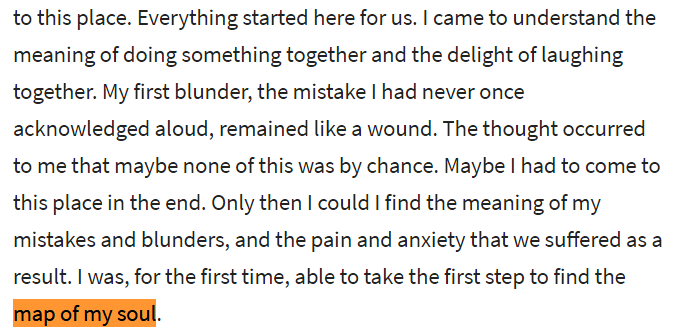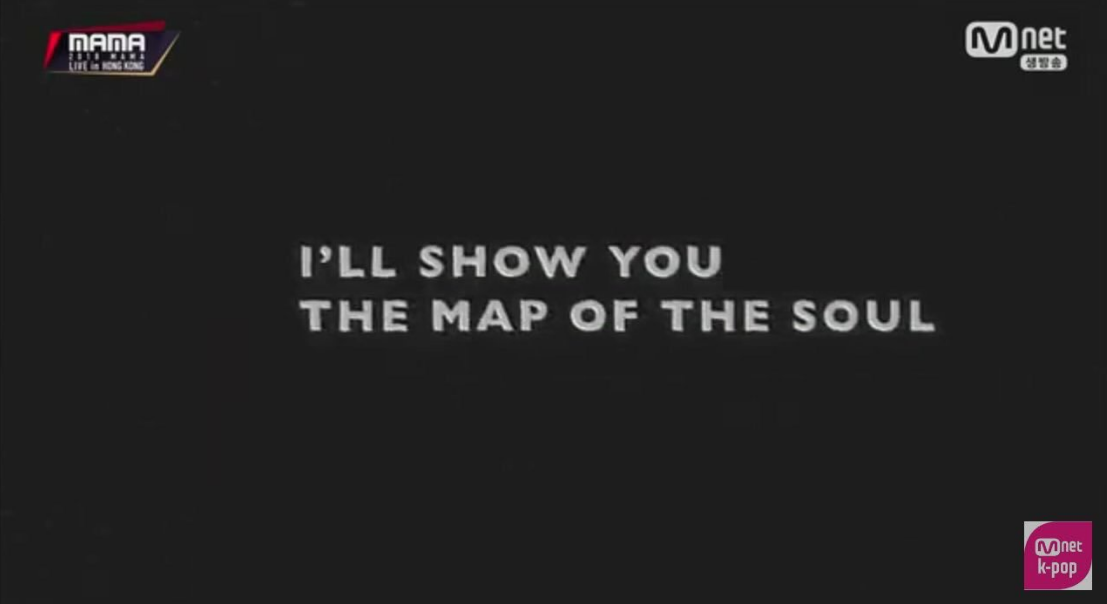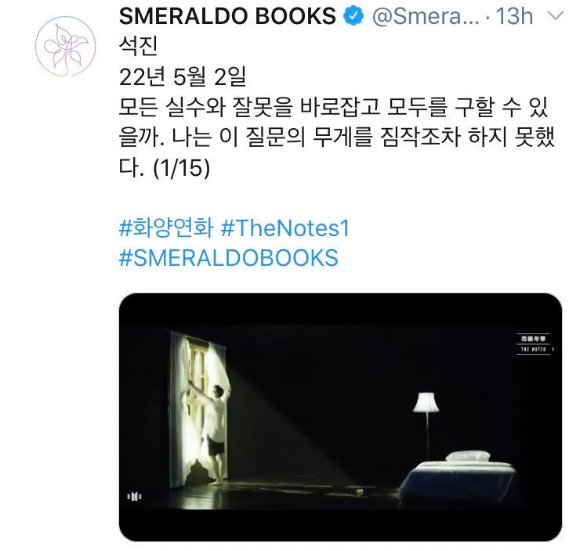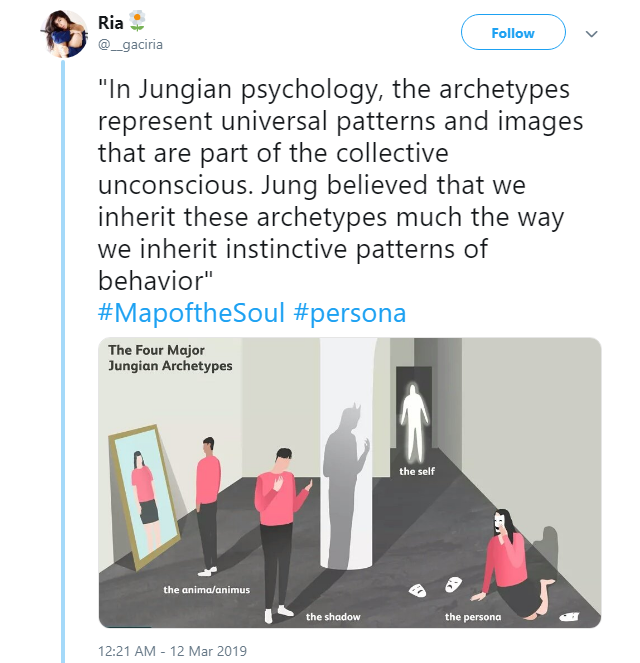In case you were under a rock or projected to outer space, BTS is coming back on April 12. They will return with a new series called “Map of the Soul: Persona” And here are the hints BTS gave us before this being announced and we saw NOTHING:
Aug 6 2018 the notes by Seokjin, last sentence ‘Start finding my map of the soul’ (Find the fill note translated HERE)  Dec 14 2018, MAMA HK ‘I’ll show you, the map of the soul’
Dec 14 2018, MAMA HK ‘I’ll show you, the map of the soul’  Same day (Dec 14, 2018), Bighit official shop the book ‘Jung’s Map of the soul’
Same day (Dec 14, 2018), Bighit official shop the book ‘Jung’s Map of the soul’  Jan 7 Smeraldo Books talk about Seokjin’s notes
Jan 7 Smeraldo Books talk about Seokjin’s notes THE BTS COMEBACK IS BASED ON THE JUNGIAN PSYCHOLOGY:
THE BTS COMEBACK IS BASED ON THE JUNGIAN PSYCHOLOGY:So this comeback will be based on the book ‘Jung’s Map of the soul’. The persona that BTS are first choosing to come back with is one out of 4 unconscious characteristics that we inherit.
 EXPLAINING THE FOUR MAJOR JUNGIAN ARCHETYPES:
EXPLAINING THE FOUR MAJOR JUNGIAN ARCHETYPES: BTS will use the ideas of Carl Jung to examine the individuation process, a process Jung believed to be essential for a healthy functioning personality. Such an examination will lead us (BTS, ARMY anyone interested …) to explore some of the parts of the personality that Jung viewed as particularly important, namely the persona, the shadow, the anima and animus, and the self.
THE PERSONA: The word persona was used in Roman times to signify a mask worn by an actor. In an analogous manner, in Jungian psychology, the persona represents the social mask that each of us “wear” in our interaction with other’s in society. Or to put it differently it represents the personality that we try to portray to others.
While the persona plays an important role in promoting social interaction and communal life, problems arise when people over-identify with their persona. As Jung writes:
“Fundamentally the persona is nothing real: it is a compromise between the individual and society as to what a man should appear to be. He takes a name, earns a title, represents an office, he is this or that. In a certain sense all this is real, yet in relation to the essential individuality of the person concerned, it is only a secondary reality, a product of compromise, in making which others often have a greater share than he. The persona is a semblance, a two-dimensional reality.” (Carl Jung)
Most people suffer from inflation of the persona, meaning that they over-identify with their “social mask” to the detriment of other important areas of the psyche. In the course of the individuation process, one must come to the realization that the persona is not the totality of their being, but rather only a small component of a much larger personality.
THE SHADOW: The first stage in the exploration of the unconscious, according to Jung, is an encounter with one’s shadow archetype. Over the course of one’s life certain personality traits elicit negative feedback and even punishment from others. This negative feedback creates anxiety resulting in these traits being pushed away from awareness into the unconscious where they form the shadow – the “dark” side of one’s personality.
To become aware of and integrate the shadow into consciousness is often a difficult and sometimes heroic endeavor. But failure to do so can create chaos in one’s life. In the darkness of the unconscious the shadow is far from impotent, but instead influences emotions, thoughts, and behaviors, in a manner which is beyond conscious control. Often the shadow finds expression through projections, whereby instead of seeing the disagreeable elements of the shadow as residing within ourselves we project these traits onto to others.
Bringing elements of the shadow into the light of consciousness is crucial if one is to correct some of these less desirable aspects of themselves. As Jung explains:
“Unfortunately there can be no doubt that man is, on the whole, less good than he imagines himself or wants to be. Everyone carries a shadow, and the less it is embodied in the individual’s conscious life, the blacker and denser it is. If an inferiority is conscious, one always has a chance to correct it…But if it is repressed and isolated from consciousness, it never gets corrected.” (The Essential Jung, Carl Jung and Anthony Storr)
The shadow, according to Jung, is not only composed of negative traits. Rather, in the process of over-identifying with the persona often people reject personality traits not because they are harmful, but because they don’t fit with the dominant social attitudes of the day. Therefore, when integrating the shadow into consciousness, one is also exposed to positive traits and creative energies that can bring about a renewed sense of vitality to life.
“The shadow, when it is realized, is the source of renewal; the new and productive impulse cannot come from established values of the ego. When there is an impasse and sterile time in our lives…we must look to the dark, hitherto unacceptable side which has been at our conscious disposal.” (Meeting the Shadow: The Hidden Power of the Dark Side of Human Nature)
THE ANIMA/ANIMUS:An encounter with the anima/animus is manifested in one’s consciousness as a meeting, in dreams or visions, with a member of the opposite gender. Such a figure often arises during times of severe psychic disorientation, offering guidance as to how to remove any psychological barricades hindering the natural progression of the individuation process. Encountering such an archetype can, therefore, signify the coming of a deeply meaningful period in one’s life, defined by significant psychological transformations:
“The meeting with the anima/us represents a connection to the unconscious even deeper than that of the shadow. In the case of the shadow, it is a meeting with the disdained and rejected pieces of the total psyche, the inferior and unwanted qualities. In the meeting with the anima/us, it is a contact with levels of the psyche which has the potential to lead into the deepest and highest…reaches that the ego can attain.” (Jung’s Map of the Soul, Murray Stein)
THE SELF: After one encounters and integrates aspects of the anima/animus archetype into one’s ego, one gains access to enter into the deepest layer of the psyche, the archetype of wholeness – which Jung called the self and viewed as the most important of all the archetypes. Proper expression of the Self is the goal of the individuation process. As Jung put it:
“… the self is our life’s goal, for it is the completest expression of that fateful combination we call individuality…” (Carl Jung)
As the sun occupies the centre of the solar system, in an analogous manner the Self is the central archetype of the entire psyche. The Self archetype acts as the unifying or organizing principle of the psyche and is oriented toward a union of the conscious and unconscious realms. Remembering from our first video on Jung that the centre of the field of consciousness is the ego,
Jung noted that:
“the more numerous and more significant the unconscious contents which are assimilated to the ego, the closer the approximation of the ego to the Self, even though this approximation must be a never-ending process.”(Carl Jung)
As one increasingly identifies with the self they will notice a greater sense of harmony both within themselves and with the world as a whole. In fact, Jung saw connection with the self as so important that at various times he described it as “a treasure that would make [one] independent” and a “link to the infinite”.
CONCLUSION: BTS are not just blatantly asking us to love ourselves, but using this next comeback to show us how to understand ourselves and thus come to an agreement with ourselves and finally love ourselves.
———————————————————————————————————–
| Wow! This took quite a bit of research and time to finish hope you like it ^^
| Cr twt choi_bts2 & __gaciria & @mimibtsghost& academyofideas.com/2016/02/introduction-to-carl-jung-individuation-the-shadow-the-persona-and-the-self/